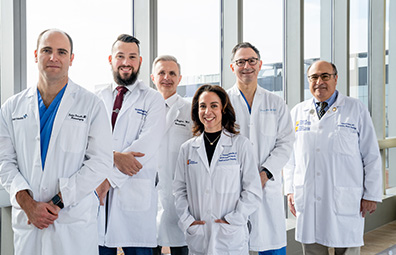Skull Base Encephaloceles
An encephalocele is a rare condition where the coverings of the brain, cerebrospinal fluid and brain tissue protrude through the skull in a small sac-like structure. Caused by an abnormality during fetal development, trauma, or the result of cancer treatment, encephaloceles can be located along the forehead, nose or within the sinuses.

Meet Our Brain Tumor Care Team
Meet the specialists at the Gerald J. Glasser Brain Tumor Center who are experts in treating skull base encephaloceles.
Meet the TeamSymptoms
Some encephaloceles are large deformities that are immediately visible. Others are very small and go undetected, especially when in the nose or sinus cavities. Symptoms include:
- Cerebrospinal fluid (CSF) leak resulting in drainage of clear cerebrospinal fluid from the nose that worsens with straining, bending or exercise
- Headaches that are worse when standing up which are caused by too much fluid drainage
- Meningitis caused by infection of the brain lining
- Hydrocephalus, the buildup of cerebrospinal fluid within the brain which can lead to headaches
Diagnosis
Although encephaloceles are typically diagnosed before or shortly after birth in children, they can also occur in adults as the result of trauma or prior skull base surgery.
Diagnosis of a skull base encephalocele is based on the patient’s symptoms, physical exam and specialized imaging studies of the brain and skull base. A high-resolution, contrast CT scan with a three-dimensional model provides detailed information about the encephalocele’s exact size and location as well as other structures impacted, anomalies or possible problems.
Treatment
Surgery is the primary treatment for a skull base encephalocele that is causing symptoms. During the procedure, your surgeon will return the encephalocele into the skull cavity, repair the skull defect and repair the coverings of the brain to eliminate cerebrospinal fluid leakage.
Our team will evaluate the size and severity of the encephalocele as well as the involvement of associated structures to develop a personalized surgical approach using traditional open skull base or minimally invasive endoscopic techniques. When possible, minimally invasive endoscopic techniques performed through the nose are used because patients often experience fewer or no incisions, decreased pain and a shorter hospital stay.
Our team will closely monitor you and personalize your follow-up care. Our patient navigator will also connect you with our support group and other resources.